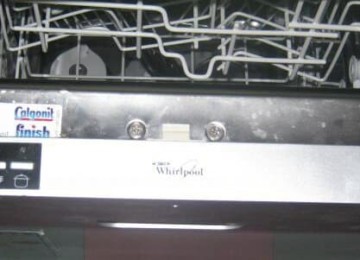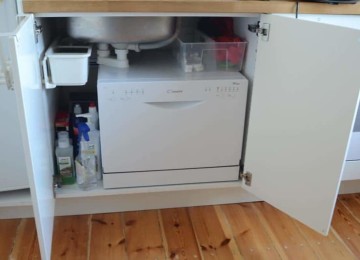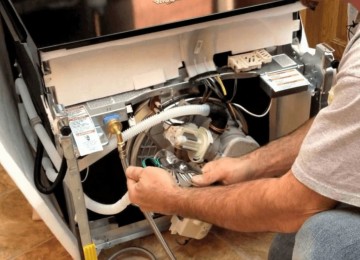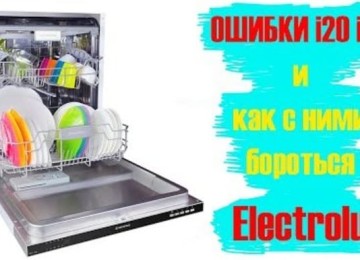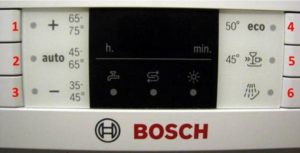 During commercial breaks, the following words are heard more and more often on TV screens: “I’m a woman, not a dishwasher.” Therefore, many people began to think about buying a dishwasher for your kitchen. One of the most frequently chosen brands on the market is Bosch. Household appliances from this company have been used by many generations not only of Russians, but also of residents of the rest of the world. Even if you take a responsible approach to the selection and installation of this unit, thoroughly study all the instructions, indicators of the Bosch dishwasher and operating tips, you can still encounter minor or major problems in the operation of this equipment.
During commercial breaks, the following words are heard more and more often on TV screens: “I’m a woman, not a dishwasher.” Therefore, many people began to think about buying a dishwasher for your kitchen. One of the most frequently chosen brands on the market is Bosch. Household appliances from this company have been used by many generations not only of Russians, but also of residents of the rest of the world. Even if you take a responsible approach to the selection and installation of this unit, thoroughly study all the instructions, indicators of the Bosch dishwasher and operating tips, you can still encounter minor or major problems in the operation of this equipment.
Description of controls
In everyday household use, a Bosch dishwasher is unlikely to cause much difficulty in use. Many lights and modes remain unused. But to use a Bosch dishwasher comfortably, you need to know what each of the signal indicators means. Let us first consider those that are present on almost all models and indicate various stages of work.
- End indicator (End) - indicates the end of the dishwashing cycle.
- Brush indicator – lights up when the dishwasher is starting.
- "Crane" indicator – signals the period of operation when the cavity of the machine is filled with hot water.
- Salt indicator (two arrows in the shape of the English letter S) – indicates the presence of a salt absorbent, which helps clean the heating element from scale that has formed on it.
- Rinse aid indicator (snowflake, sun, star) – indicates the presence of dishwashing liquid in a special compartment.
The keys responsible for setting and regulating the upcoming wash are allocated to a separate category. Functional every Bosch model is very different, so only those buttons that are encountered most often will be described.
- "Pot" – This symbol indicates an intensive dishwashing cycle at temperatures above 70 degrees Celsius and lasting about an hour. Used for the heaviest stains.
- "Cup and Saucers" (or Auto mode) – standard operating mode. Similar to when we wash dishes by hand. Water temperature – 50 degrees. Duration – up to two hours.
- "Cup and plates" (ECO, economy) – reduced water consumption mode. It differs from the standard one in the presence of a rinsing stage.
- "Glass (cup) with two arrows" – accelerated washing. It passes in half an hour at a temperature of about 40 degrees Celsius.
- "Wineglass" – delicate mode. Used for fragile dishes.
- "Baby food bottle" – treating dishes with hot water, which destroys germs. Used to disinfect baby supplies (dishes, pacifiers, etc.).
Types of faults
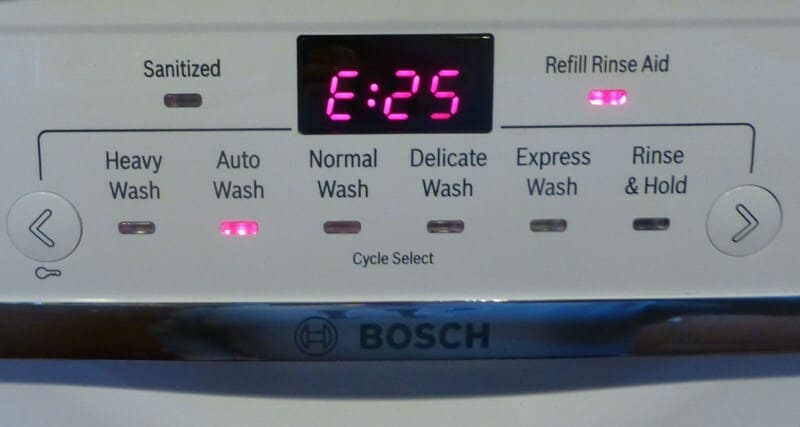
Most problems that can occur with a Bosch dishwasher do not lead to its complete failure. Modern equipment is equipped with sensors that prevent them from starting if any part is in poor condition. The user will be notified of this either by flashing indicators or an error code on the display Bosch dishwasher.
Moreover, the exact startup error can only be determined by putting your dishwasher into service mode. To do this, you need to hold down a combination of some indicators on the panel, which is described in the instructions. Those signals that can be seen in normal mode give only an approximate indication of the problem.
Types of errors on devices without a digital display

This type of error is not standardized, so this section will look at some options for displaying it on various panels. In order to find out how to eliminate them, a digital code (for example, E4) will be given at the end, which will be deciphered in the next section. We remind you, do not forget to translate Bosch dishwasher into service mode.
A panel that displays up to three digits:
- 0 - No problem;
- 1 – faulty water supply indicator (E6);
- 2 – error in the water heating system (E01);
- 4 – the reservoir is not filled (E3);
- 8 – breakdown of the thermometer (E2);
- 16 – malfunction of the flow regulator (E4).
Panel (display) with two lines:
- S3 – no problems found;
- A or B – error in receiving data from the aqua sensor (E6);
- E – there is no signal from the flow switch (E4);
- F – water does not enter the working cavity (E3);
- G – flow switch does not stop (E5);
- H – problems with the heating element (E01);
- K – short circuit or wiring fault (E2).
Types of errors on devices with a digital display
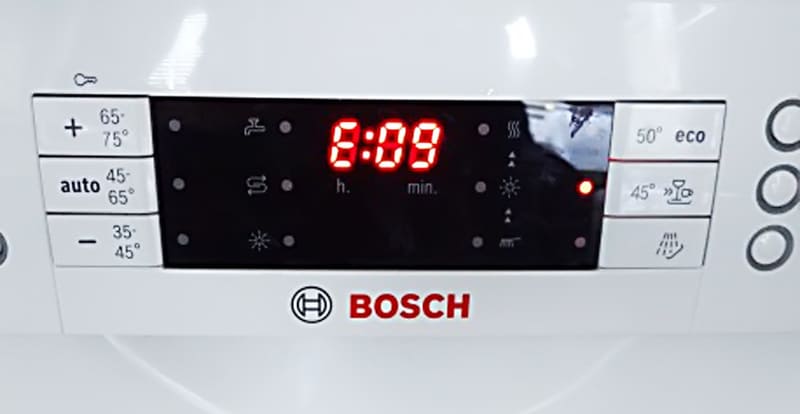
Most modern Bosch dishwashers equipped with such digital panels. Error indicators will light up on them if the dishwashing process failed to start. This facilitates the diagnostic process, and therefore the speed of repair.It is highly not recommended to repair such complex equipment yourself. Contact the appropriate service center. We remind you, do not forget to put your Bosch dishwasher into service mode.
- Uniform flashing of all indicators – software failure;
- E01 – control unit failure;
- E1, F1 – sensor malfunctions;
- E02 – broken wiring;
- E2, F2 – heating errors;
- E03 – drying does not occur;
- E3, F3 – the tank does not fill;
- E04 – see E02;
- E4, F4 – malfunction of the spray mechanism;
- E05 – see E01;
- E5, F5 – leakage or overfilling of the tank;
- E06 – the chamber is not sealed (problems with the locking mechanism);
- E6, F6 – failure of the incoming water quality sensor;
- E07 – fan failure;
- E7, F7 – clogged drain pipe;
- E8, F8, E08 – low water level;
- E9, F9, E09 – problems with power supply to the heating system;
- E10, F10 – see E03, E07;
- E11, F11 – no data from temperature sensor;
- E12, F12 – contamination of the heating element with limescale;
- E13, F13 – the incoming water temperature is too high;
- E14, F14 – error in the water distribution system;
- E15, F15 – tank leak;
- E16, F16 – valve leakage;
- E17, F17 – too powerful pressure of incoming water;
- E18, F18 – see E3, E14;
- E19, F19 – system malfunction;
- E20, F20 – problems with the pump;
- E21, F21 – see E3, E20;
- E22, F22 – clogged drain system;
- E23, F23 – breakdown of the pump responsible for removing water from the tank;
- E24, F24, E25, F25 – see E22;
- E26, F26 – flow sensor failure;
- E27, F27 – problems with the electrical network;
- E28, F28 – see E6;
- E29, E30, F29, F30 – see E27.






